Viadal 6 day: postrace
As expected, the Viadal 6 day didn’t go well. I walked the first 60-ish miles, and my speed dropped from 14.5 min miles to 17ish min miles more quickly than usual. On the first afternoon various aches and pains flared up, including my lower back. However, as I’d hoped, they eased off. Two weeks later my back is still much better than it’s been for months (I’d like to credit this to ultra-running, but I suspect that actually it’s due to less driving and sitting at a desk…)
As planned, towards the end of the first day I deployed my multi-day shuffle. I started by just shuffle-running the steady gentle downhill section of the loop. That didn’t cause any problems, so I gradually increased the shuffling until I was only walking the ‘steep’ (in relative terms…) sections of the loop and back averaging 15ish min miles. For a little while I thought that maybe I could keep this up for 6 days and rack up a decent distance.
After 24 hour I’d only done 72 miles. On day one of previous 6 days I’ve managed between 79 and 87 miles (the 79 was at EMU 2019 where I walked most of the first day). Beforehand I’d thought that anything in the 70s would be OK, since I knew I’d be walking more slowly, however 72 felt a bit disappointing. It could still project to a decent distance though, if I executed the remaining days better (i.e. wasted less time) than at EMU where I finished with 361 miles. I didn’t have a fixed number in mind for ‘decent distance’, but I think I’d have been happy in the ‘not being able to walk without trekking poles 6 weeks ago’ circumstances with anything above 350.

a rare outbreak of running (credit: Viadal Ultra)
Not long into day 2 it became apparent that my shuffle wasn’t functioning as well as usual. Doing it continuously was hard work, and I switched to alternating 2 shuffling laps with 1 walking. More significantly both my legs, and in particular the injured right one, started aching. Not the injury itself, but the other side and back of my leg, presumably from compensating for the injury. The first couple of hours of the post-lunch and dinner blocks both went OK, but mostly it was a struggle, both mentally and physically. Six day races inevitably have low patches, but this was too much too soon, and I decided that it just wasn’t worth it for the sort of distance I’d be able to manage. There was also the risk of making the injury significantly worse, or causing other issues. So I decided to get to 100 miles and stop.
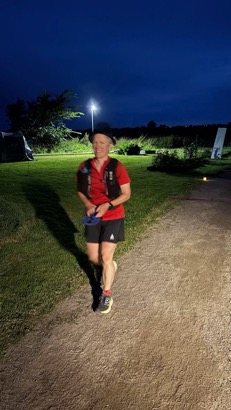
happy to get to 100 miles and stop (credit: Viadal Ultra)
After doing my celebratory lap with the black 100 mile hat I told the timing people I was stopping. ‘For the night?’. ‘No, forever’. However I decided to hang onto my timing chip just in case. I slept extremely badly that night. Even after painkillers both my legs were very painful and any movement woke me up. The next day, walking was awkward and I didn’t question stopping being the right decision. After 2 largely sleepless nights (I never sleep well during the first night of a multi-day event) I was really tired and spent most of the day dozing, eating and surfing the web.
The location, in the Swedish countryside, was pleasant, and the weather was hot and sunny (far hotter and sunnier than ideal for six day running), so I settled into reading my big pile of books. People were sympathetic and, unlike Six days in the dome (where I was in a far worse state), no one tried to tell me I should have kept going. I do regret inadvertently being dismissive of distances that I later realised other people would be happy with (“My PBs 393 miles, so there’s no point suffering 4 days of pain to end up in the low 300s.”).

one of many beautiful sunsets
I’m not very good at doing nothing. Therefore having four days with nothing to do but eat at fixed times, read books, and hang out with other runners’ support crews was probably good for me. However there was a lot of time for navel gazing. I pondered if I’d given up and stopped too soon, but eventually convinced myself that stopping was sensible. The most sensible option would, of course, have been not to even start the race. However if I’d applied similar logic to the Kauhajoki 6-day then I wouldn’t have a 393 mile 6 day PB. My big mistake was not seeing a physio in the Spring when the initial niggle didn’t clear up.

trying to 'do nothing' (credit: Viadal Ultra)
Inevitably my mind turned to aging and future plans. There are people (including several at Viadal) doing impressive things well into their 60s, and beyond. While I know that I’m lucky to be (in the grander scheme of things) very healthy (and alive), my body is clearly declining and my window for ‘doing big things’ may be closing. Do I really want to spend the next few years obsessing about an arbitrary milage goal (400 miles), that in fact I’ve already got close to? It’s easy to think in black and white terms, but 393 miles is actually a fairly light shade of grey, especially since my initial target was 350-400 miles. I made a decision I’d been pondering for a few weeks: I wouldn’t give up on 400 miles per se, but would ‘park’ 6 day running for the next few years and do other things. Lately there haven’t been other races (apart from a multiday arctic ultra) that have really appealed to me. However during the 6 days I discovered that in 2025 the Oslo Bergen trail allowed solo runners and also heard about the Gotland Run 511k (a Swedish Last Annual Vol State-esque journey run).
In an attempt to focus positively on the future, I booked a Strength and Conditioning appointment with a physio. Partly for specific strength training for the Lapland Arctic Ultra next year, but also to hopefully help prevent injuries in future. For the past year I’ve benefitted from being much more careful about my energy levels. I need to do the same thing for my ‘chassis’. I also spent a lot of time (and a large fraction of my mobile phone data allowance…) researching potential trekking holidays to the more remote parts of Nepal or Bhutan for Sping 2027 (to make the most of being able to take annual leave during term time then).
Over the four days my legs recovered to ‘not much worse than they were are the start’, so I decided to put my running gear back on and walk the last few hours. I’d wondered whether joining back in for the fun bit at the end was a bit cheeky, but everyone I mentioned it to seemed to think it was a good idea, so I did. It was sufficiently slow and uncomfortable to confirm that stopping had been a good decision.
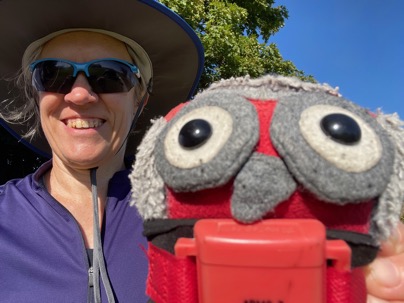
taking race mascot Helge the owl out for a lap
When I left Viadal I thought I’d come to terms with not just the outcome of this race, but also taking a break from 6 day running, after 3 years of unsuccessfully chasing 400 miles. However once home I felt deeply discontent. I eventually realised this was because taking a multi-year break from 6 days, would mean effectively giving up on breaking 400 miles. So in the end I settled on a ‘middle road’ plan: I focus on other races, but with the idea of entering a six day at short notice if I find myself in good shape. The Oslo-Bergen and Gotland races are both in July, so the Czech 6 day in early May could work well. Viadal was really well organised though, and if I ever want to do another 6 day in mid-Summer, it would be my first choice.
The period bit at the end
The race did have one positive outcome: the coil did its job! I just had one day of light spotting and no cramping (it wasn't noticeable above the leg pain at least…)
Viadal 6 day: prerace
I haven’t had the best luck with six-day races in the last few years. In 2022 Covid messed up my training for Kauhajoki, but to my surprise I still managed a more than decent distance (393 miles). In 2023 I went into Six days in the Dome fit and uninjured, with lofty goals. However 3 and a bit days and 200ish miles in I had to stop due to a badly swollen lower right leg that wouldn’t bend at the ankle, plus a hacking cough that was stopping me sleeping and making me puke. In 2024 a flight cancellation stopped me getting to the start of the Viadal 6 day, but saved me from digging deeper into the chronic fatigue hole I’d not yet realised I was in.
I spent the Autumn and Winter walking and then cycling, as anything that made my heart rate go above 160 bpm wiped me out for days. By Spring 2025 multi-vitamins and HRT (plus being more careful about not overdoing things at work) had sorted out my energy issues. I entered the Viadal 6 day in August again, and got back to running. The first short run was slow, but otherwise no cause for concern, until the next day when my right lower leg was very sore. The pain faded over a couple of days, and I was able to go ahead with a short backpacking trip on the 2nd half of the Dales High Way that weekend.

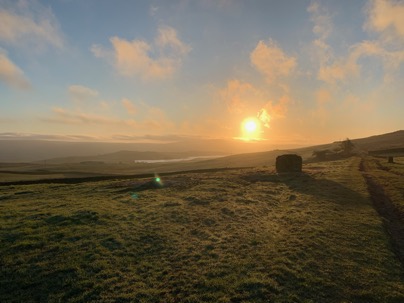
Sunset and sunrise on the Dale High Way (separated by a chilly night in an ice encrusted tent)
The pattern of ‘fine when running, sore for a few days afterwards’ continued for the next few months, but overall things seemed to be going in the right direction. The short runs got a bit less slow, slower than they used to be, but at a level I could live with (and attribute to aging). I built up the weekend long walks and run-walk-jogs to the level I’ve been managing for the last few years. Somewhere along the way the niggle evolved into being a constant ache which eased off after a mile or so of moving.
In late May I did the Long Distance Walkers Association 100, as part of a long-term goal to finish 10 of their 100s before I turn 60. Given the goal was just to finish, I decided to copy my 2022 post-covid LDWA100 strategy: walk the first ~30 miles and then shuffle the flat-ish bits after that. My legs were initially achy, but they eased off by the end of the day. I finished comfortably in under 32 hours, which I was fairly happy with. I was behind some walkers, but ahead of some people who’d run from the start.

shuffling, ~90 miles in to the LDWA100
I recovered fairly quickly, and eased back into training. However things went badly wrong in late June, a few minutes into a short treadmill run. The initial aches eased off as usual, but after a minute of running normally my gait became awkward, and then my right leg suddenly ‘went’ and I came to an abrupt stop. My right leg wouldn’t weight bare while bent at all. I had to drag myself (literally) up the stairs to bed. In the midst of a sleepless night where I mentally cancelled all my running and hiking plans for the foreseeable future, I booked the next available appointment with a physio I’d been recommended for foot and leg issues.
The next day I could only walk with trekking poles, and had to take stairs ‘two feet per step’. Things initially improved quite rapidly. After a couple of days I ditched the poles and within a week I was doing day-to-day stuff fairly normally, but walking was somewhat slow and uncomfortable. The physio diagnosed me with a weak ankle (one of the joys of hypermobility…) placing strain on my tibialis anterior, and dispatched me with some exercises.
Over the next few weeks I got back to walking long-ish distances at a reasonable pace (about 20 seconds per mile slower than my usual sustainable long distance walk). The original injury didn’t ache too much, but I developed various other aches (most significantly my lower back), presumably from compensating for the injury. I tried jogging on a couple of occasions, but it felt awkward and my leg was sore the next day, so I gave up on getting back to running.
My plan is to go to Viadal, walk the first day and see how things go. The best case scenario is that my multi-day shuffle still works and I can rack up a not-too-embarassing distance while trying out some potential fixes to issues: baggy shorts to avoid chafing, new sources of calories for when I’m feeling sick on days 2-3, and a coil to stop heavy bleeding (more about this in ‘the period bit at the end’). Anything over 100 miles will be an ‘over 50 distance PB’, so that’s a very low initial target to aim for. Unfortunately my brain can only get my body to do my multiday shuffle after 24+ hours of runing or walking, so I don’t know how much it will be affected by the injury. In 2019 I managed to shuffle my way through the EMU 6 day without running more than 3 miles in one go beforehand, so it’s not impossible that it’ll be OK. However it’s very possible that the compensation niggles, in particular the lower back, will grind me to a halt. All I can do is play the cards I’m dealt (and pack lots of books in case my ‘race’ comes to an early end).
I’m not as miserable about my ‘400 miles in six day’ plans getting derailed yet again as I would usually be, as I’ve already got one eye on 2026 and a very different adventure. Various things (including a Leverhulme Trust Research Fellowship) have aligned so that I can fulfill a long-term dream and enter a multi-day Arctic race (the 500k Lapland Arctic Ultra). I did the Rovaniemi 150 in 2020, but a multi-day race is a very different challenge, and something I’m really looking forward to.
The period bit at the end
With heavy, painful periods having become a significant issue in everyday life as well as during multiday races, I decided to get a coil fitted. When a menopause specialist initially suggested this I was reluctant as I’d had a painful, failed attempt at getting one fitted by my GP in my 20s (apparently my womb/cervix points in a funny direction). However I was sufficiently desperate to give it another go, and hopeful that getting it fitted by a specialist at a sexual health clinic would go better. It was still painful and not straight-foward (the nurse said she ‘could see your GP meant') but eventually it went in and stayed in. Since then my periods have been extremely light, and less painful, so fingers crossed the coil will also resolve the ‘heavy period arrives early during multiday race’ issue.
"It's not 1992 and you're not 18 any more"
quote: L7, Electric Ballroom Camden, 16/06/24 (they actually said 21 rather than 18, but I've modified it to make it fit better).
2024 ended as it started, with a Zwift route completion habit, but in the middle things went somewhat wrong…
I started Zwifting in Summer 2023, while recovering from the injury which wrecked Six days in the Dome. 'Getting a Tron bike and completing every single Zwift route' was then the crutch which got me through the aftermath of my Dad's death in Autumn 2023. Thanks to slightly more cycling than was probably sensible, I got the Tron bike by the end of January, and by mid-February I'd done every route apart from the longest one, the PRL Full in London. It was a while before London was available at a weekend when I had sufficient time and energy. I gave up 5 hours into my first attempt, when I realised I was going to be finishing late and knackered before a busy week. I finally managed it (taking 8 hours and 13 episodes of Killing Eve) 10 days before my first race of the year, the Pennine Bridleway Trail Challenge. I'd entered the Pennine Bridleway as a fun multi-day warm-up for the Viadal six-day in August. Overall it was fun. However, my middle-aged (female) body threw me some fairly big curveballs: the heaviest period I've ever had, long-sightedness making navigating at night in a storm hard, and difficulty staying warm (when moving slowly due to the navigation issues…).
 .
. 
Happy at the finish of the Pennine Bridleway, and with my new bike (and a Green sprint leader jersey)
Things went badly wrong in late June. I'd been working hard for months, because of trying to catch up on things I'd got behind on in the Autumn, a major new responsibility, and multiple big deadlines which involved a lot of herding other people. And in the midst of a busy couple of weeks (which included a trip to London to see L7 play all of the Bricks are Heavy) I got covid and my body (and head) waved a little white flag.
I was planning to still give the Viadal six-day a go, but (fortunately in retrospect) my flight to Copenhagen got cancelled in mid-air. I instead spent an enjoyable week at home doing not a lot. When I tried to get back to exercise in September things were still very not right though. On a ten mile walk in the Peak District my heart rate hit 170 going not particularly fast uphill, and I was exhausted (with elevated resting heart rate and depressed heart rate variability) for a week afterwards. I also had 2 heavy periods within the space of 10 days, so I started taking multi-vitamins and iron and booked an appointment with a private menopause specialist (something I'd been humming and hawing about doing for a while). As well as prescribing HRT, she nudged me into booking a GP appointment. I initially struggled to convince the GP that there was anything wrong with me ("I'd be happy with a resting heart rate in the 50s"). But "I can usually do 60 miles a day for mulitple days, so being exhausted after 10 miles is not normal" did the job, and she ordered a battery of blood tests, an ECG and lined up various other referals (including a long Covid clinic) if necessary. The blood tests came back fine, apart from low vitamin D levels, even though I'd been taking multi-vitamins for 4 or 5 weeks.
During the Autumn I took things as easily as possible: yoga, weights, no cycling and running, only short and slow walks, eating better, sleeping more, and not overdoing things at work either. And slowly I'm beginning to feel like myself again. I took 2 weeks off work over Christmas/New Year and have started Zwifting again. Initially my Garmin told me off for over-doing it, but my heart rate is coming down and my speed and watts are going up, so thing are going (cautiously) in the right direction. The boundary between 'absolutely no after effects' and 'wrecked the day after' is at a much lower level, and much narrower, than 'old normal', but I'm no longer getting wiped out for a week by 10 miles of walking.
The priority for 2025 is not breaking myself again (mantra "It's not 1992 and you're not 18 any more"). If things go well I'd like to have another go at doing the Viadal six-day, but I won't commit to that until I've got a bit more training under my belt (the big uncertainty is what my body can handle once I'm back to work and commuting). My short term goal is completing the rest of the new Zwift routes, and I'm hoping to get an entry for the LDWA 100. I know from 2022 that (provided I start slowly) I can comfortably complete a LDWA 100 with very little training/fitness. And 'completing 10 LDWA 100s before I turn 60' is a new, suitably sensible, middle-aged goal (especially since I already have 4 'in the bag').
The Six Days that wasn't
This week I was supposed to be in Viadal in Sweden running a six-day race. Instead, thanks to SAS, I’m sat at home. However maybe SAS saved me from digging myself into a big hole.
Recovery from the Pennine Bridleway Challenge in April was slower than I’d have liked. However by mid-June things were going OK, certainly much better than when covid derailed the run-up to the Kauhajoki 6 day in 2022. Then (during a stupidly busy few weeks at the end of a challenging academic year) I got covid again. Thankfully I recovered sufficiently to go on a big holiday (a 2.5 week trip to Japan to celebrate my 50th birthday). But I wasn’t quite right: less energy than usual and a lingering cough which got worse again on the journey home. A 3-week gap between the holiday and the six-day race was never going to be ideal, however, there aren’t many six-days which fit in with University term dates. In retrospect I probably should have spent those 3 weeks resting, however, I didn’t want to go 2 months without any training. Running gently didn’t seem to make the cough any worse, so I did a few easy 3 to 4-hour run-walks and a couple of short runs, followed by a week of no exercise. I’d hoped I’d feel better after the rest, however as the week went on I felt worse and worse. The breathing issues were joined by digestive weirdness and tiredness, my RHR rose and HRV dropped. I wasn’t sure that trying to run-walk for six days was a good idea, but I decided to go to the race with a big pile of books, take it easy and see how it went.
I was supposed to be flying from Manchester to Copenhagen on Saturday morning. A 2-hour train ride followed by a lift from the train station would get me to Viadal by late afternoon. I should have had plenty of time to get my tent sent up and relax before the race started at midday on Sunday.
I started worrying at about 9.30 when the departure board still said ‘relax, gate announced at 9.05’. Not long after I got a message from SAS saying the flight was delayed by 3 hours. A bit annoying as I could really have done with another 3 hours sleep, but not a disaster. After messaging the race organisers about my delayed arrival, I had a big late breakfast and killed time by messing around on my phone. I looked up the incoming flight on Flight Radar. It was on its way to Manchester, having diverted back to Copenhagen after its initial take-off. I’m a planner and always like to have plans B, C and D. Having experienced a poorly handled SAS flight cancellation last Summer, I started investigating alternative routes. It didn’t look good; the only way of getting to Copenhagen by mid-morning Sunday from Manchester involved a six-hour overnight stopover at another airport.
The departure board never updated and I got increasingly irritated by the cheery ‘relax’ message. I only found out the gate number by constantly refreshing the SAS app. After a delay while passengers found their way to the gate, we eventually took off just over 3 hours late. I settled into reading one of the books I was carrying. 30 min into the flight the pilot made an announcement and my heart dropped. It was in Swedish first but (thanks to the 2 years I spent living in Stockholm in my 20s) I understood the gist of it: we were returning to Manchester due to an issue with the plane.
Fire engines were waiting for us and the plane used a lot more runway than usual to come to a stop. We spent a long time at the end of the runway before taxiing to a distant corner of the apron. The phone signal was too weak for me to research alternative flight options, but I texted the OH and he got on it for me. It was now too late for the alternative route I found earlier. The ‘least worst’ option was to get a train to Edinburgh and a very early Ryanair flight which would get me to the race a couple of hours after it started.
Eventually, the flight was cancelled (by email, no announcement was ever made) and we were bussed back to the terminal to collect baggage. Even that wasn’t completely smooth. The automatic passport gates wouldn’t let me through and I had to go to a border agent:
Them: ’Where’ve you come from?’
Miserable me: ‘nowhere’
Them: raised eyebrow
Miserable me: ‘my plane just returned here’
Once land-side I phoned the OH to talk through what I wanted to do. During the call, a rebooking email from SAS arrived. They’d put me on a flight the next morning via London which wouldn’t even get into Copenhagen until after the race started. I seriously considered the Ryanair Edinburgh option. Realistically I’d be at least 4 hours late starting the race (which would cost me ~14 miles). Worse than that I’d be exhausted before I even started and I was already feeling pretty tired. I decided to cut my losses and get the train home again.
I was expecting to have a big cry at some point but the tears never came. The closest I got was when the race organisers kindly replied to my email saying I wouldn’t make it to the race saying they’d refund my full entry fee. I also vented some of my anger/frustration by composing a complaining email to SAS (and have subsequently at least been told I’ll receive a full refund, there may still be a battle to be fought for the compensation).
I spent Saturday evening and most of Sunday feeling pretty miserable. After 393 miles in Kauhajoki in 2022, a 400+ mile six-day felt tantalisingly within reach. Two years later, I haven’t even got close. Last Summer ‘Six Days in the Dome’ went badly wrong. This year I didn’t even make it to the start. I was quietly hoping 400 miles might still be possible since I managed 393 off very little training. However, this time I was lacking health rather than fitness/training, and potentially if I’d started I could have caused myself long-term issues. Having just turned 50, time and health are both beginning to feel finite. (And I feel guilty being unhappy about this, given that overall I’m lucky to be fairly fit and healthy.)
At the peak of my miserablism, I wondered whether multi-day running (and chasing 400 miles in six days) was worth it any more. Are the highs now too few and far between to justify the time, energy and expense? At some point, the answer might well be no, but I don’t think I’m quite there yet. While there are some lessons to learn, I’ve also had a lot of ‘one-off’ bad luck. For the last year, life has felt like a driving game, where I’ve been trying to navigate a high-difficulty course at high speed while unexpected obstacles get thrown in my path. This week, with a week off work and no plans, I’ve been able to do what I want when I want. And I’m feeling much much better, both physically and mentally, so maybe SAS did me a favour. Potentially last week my body was trying to tell me that running for 6 days was a bad idea (it’s also possible it was just an extreme case of stress-induced ‘taperitis’).
The cough/chest seems to be getting better and I already fancy a run or bike ride. But I’ll be sensible and continue resting until I’m 100% better. And in the meantime, I’m making plans for next year, bearing in mind the lessons I’ve learnt this year:
i) arrive at overseas races two rather than one day in advance,
ii) prioritise health over fitness.
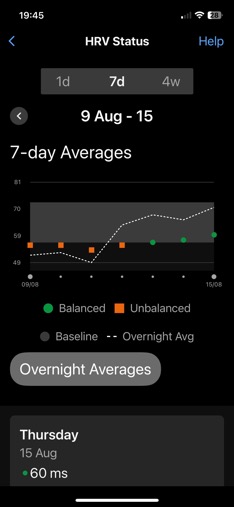
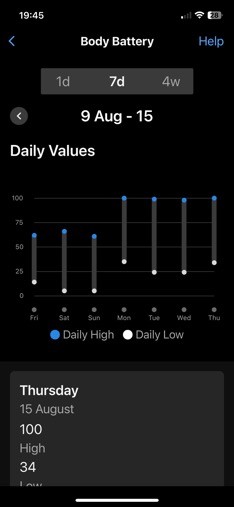
The benefits of a few days rest.
Pennine Bridleway Trail Challenge
In 2022 I DNSed the inaugural 270km Pennine Bridleway Challenge when a sore throat turned out (with a positive test on the morning of the race) to be covid. I entered the 2024 edition with the same plan: a sleep-deprived walking holiday as six-day training. And again I got ill the week before, first a urine infection (which was knocked on the head with antibiotics) and then a cold. It wasn’t clear I was in a fit state for a multi-day event. But it was close to home, with very generous cut-offs, so I decided I’d start and pull out at checkpoint one if I wasn’t feeling up to it.
Trains weren’t running properly so the OH gave me a lift to registration in Hayfield. As we drove through the Peak District it hailed heavily, covering the roads in slush and I changed my kit plans for stage 1 to include a heavy-duty waterproof. After a night in a B&B up the road I hauled my drop bag back to Hayfield for breakfast before the bus ride to the start at Middleton Top. While waiting I got talking to a woman who I initially assumed was another entrant but was actually the partner of one of the runners. The Spine Race came up in conversation (tbh it was probably me that brought it up, I’ll probably still be dining out on it in decades time in an OAP home). And we had ‘the Spine Q&A’. It usually goes:
Other person Q1: So you’ve done the Spine?’
Me: `Yes’
OP Q2: ‘the full race?’
Me: ‘Yes’
OP Q3: in Winter?’
Me: ‘Yes’
OP Q4: ‘And you finished?’
Me: ‘Yes’.
This time I pre-empted questions 2 and 3, but question 4 still came. I sometimes feel like wearing a badge/T-shirt with the Q&A on plus ‘Yes really, I know I don’t look like the archetypical Spine finisher, but I did’.
The first section on a disused railway should have been nice and easy, but a headwind, runny nose and lack of fitness made it a bit of a slog with a lot more walk breaks than normal. As usual for day one, I was close to the back of the field. I think there were 2 people behind me (one of whom dropped out early) and the other 3 women were fairly close in front. I backed-and-forthed with Lizzie (and she held gates open as I struggled to keep up with her on uneven terrain) before passing her for good when she stopped at a cafe. Deploying my shuffle on flat sections, I started pulling back the other 2 women, but they pulled away again as the route into CP1 at Hayfield got hillier and more uneven.
Thanks to a quick stop at CP1 I headed out first into the night, feeling surprisingly pretty good. I had a few small navigation issues when the route deviated from the Bridleway around Glossop for safety reasons. It was sometimes difficult to follow the alternative route ‘on the ground’ using my 1:40,000k Harvey’s map (in retrospect having a 1:25,000k OS map for this bit would have been helpful).
The night was chilly but generally pleasant, apart from when the route went down a footpath which was ankle-deep in icey water to avoid the parallel road. As usual, I started struggling to eat, but as the morning went on dried mango and rolos went down OK and my appetite came back sooner than usual. The morning was nice and Sunny, but a storm I’d been warned about at the mid-stage waterpoint came in a couple of hours before I reached CP2 at Hebden Hay. At that point, the rain wasn’t heavy enough to require waterproof trousers, but I put them on so my running tights wouldn’t get wet and unusable for the next stage. At this point the field was still fairly bunched; there were a handful of people getting ready to leave when I arrived and the rest of the field arrived before I left.
After eating a jacket potato and cheese, I had a dorm to myself for a couple of hours of sleep, before kitting up to head back into the storm. The weather in the valley wasn’t bad, but I was warned it was much worse up on the moors. I got my poles out, as the steep stoney descents towards the end of the previous stage had made my knees sore.
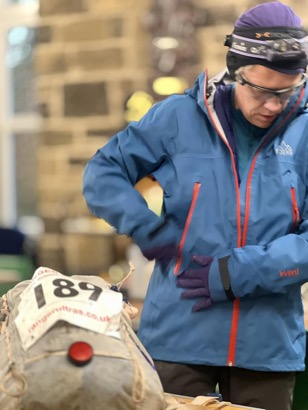
Getting ready to leave CP2 Hebden Hey (new headtorch upside down…).
The poles and rain, combined with middle-aged long-sightedness, caused some issues. I like to navigate mainly by map, using GPS to find turns. However, with poles in my hands, I no longer had easy access to the map. When sorting kit before the race I discovered that the ‘holding the map/GPS at arm’s length’ trick no longer works, in particular in the dark. I panic bought some bi-focal orienteering glasses and up to this point they’d worked well. However I hadn’t thought about how to keep them dry in a storm, and I struggled to follow the route across a pathless section of boggy moor using my GPS (fortunately I had a handheld GPS, with just my watch it would have been even worse). I also suddenly started feeling extremely sleepy. This was very unexpected; usually on multi-day races tiredness hits me just after dawn and bad weather wakes me up. I was also finding it harder than usual to stay warm and put on all the spare clothes I was carrying. I never felt unsafe, however, my margins were far smaller than I’m comfortable with. I decided that if I didn’t start feeling better and/or the weather didn’t get better I’d drop out at the water point at the next roadhead. In the meantime, there was nothing for it but to keep moving slowly forward in roughly the right direction. I did however fantasise about an alien spaceship (a stereotypical 1960s ‘flying saucer’) landing and giving me a lift.
Navigation got easier once the race route rejoined the Pennine Bridleway. The storm also eased so I could stop and eat some Kendal mint cake which perked me up. I was plodding along quite happily when a pair of headlights started coming towards me. Who on Earth else would be out here at this time of night, in this weather? Two of the race safety/support team in search of me it turned out. Apparently, my tracker wasn’t working and they’d been expecting me to arrive at the water point much sooner. I told them I’d had a tough patch, but was now fine, just slow. Quite how slow only became apparent when, having checked I wanted to continue, they sped away from me back to the roadside. At the roadside, I sat in a camper van and ate some snacks while my tracker was changed. There was also a hot water incident. I asked for some hot water in one of my bottles. I took a big mouthful, not realising it was in fact nearly boiling. I spat it straight back out again onto the floor, but still ended up with a very sore tongue for the rest of the race.
The night still had some more curve balls in store for me. Stopping at the public toilets in Wycoller I discovered my period had started (possibly the cause of the unexpected tiredness earlier in the night). It was 10 days early, but over the last few years it’s done this repeatedly during races and I now carry 24 hours worth of tampons in my first aid kit. The normal tiredness hit around dawn. Usually, a caffeine speednut sorts this out. I only managed one mouthful which I promptly regurgitated, and then struggled to keep the rest of the contents of my stomach down.
When I stopped to take my warm night layers off I messaged the OH to tell him about the broken tracker, it turned out that the race organisers had already let him know. Overall the day went better, but I suffered the indignation of being overtaken by a couple of middle-aged walkers. To rub salt in my wounds they then sat on the only bench I’d seen all day (and I was desperate for a sit down). Another snafu was stopping for a wee in some woods, and then realising that the van I could see in a nearby layby was not empty and was in fact the next water point. After endless wet fields there was a long but pleasant climb up a hill above Settle. The steep tarmac descent into Settle, and being overtaken by another walker, was less enjoyable.
At CP3 I was very well looked after; I managed a whole pizza with side salad and pudding. After a couple of restless hours of sleep (I’d stupidly packed a lightweight sleeping mat despite not having to carry it) Jo did a fantastic job of taping my blisters and sent me off into the night with some sandwiches. The 3rd night was (apart from my period throwing a big spanner in the works, more about that at the end) really enjoyable; the sky was clear and the route went across some wonderful sections of open fellside. I did have a strange experience before dawn though. Two lights appeared, moving somewhat randomly. Initially, I thought it was 2 people, potentially poachers, and I steeled myself for a potentially difficult encounter. Eventually, I realised that it was (probably) lights from houses in the valley moving in and out of view.
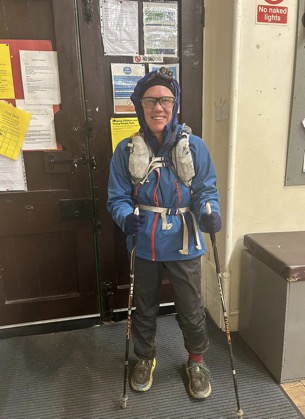
Leaving CP3 Settle (headtorch at a jaunty angle).
The Cam High road is usually a slog. But this time, on a Sunny morning with no one in sight, I loved walking up it, smashing frozen puddles with my poles. It soon became very hot, and I went from wearing full winter gear to overheating and struggling to fit the now unneeded layers in my pack. The Dales looked gorgeous and I enjoyed going past bits of the Fellsman route. I was however demoralised by quite how slowly I was moving. Despite feeling pretty good I was only managing ~2mph, rather than my usual ‘big pack uneven terrain’ minimum plod speed of 2.5mph.

Arriving at the water point at the top of Cam High road.
The steep tarmac descent to the final waterpoint at Garsdale station was painful again, but I felt better after being cheerfully plied with more snacks and dispatched with a bag of biscuits. Eating them was a bit disconcerting though as crunchy bits of flesh came off my burnt tongue. After a familiar section of the Lady Anne’s Way, the last few miles to Kirkby Stephen passed through fields covered in slurry with a vomit-inducing smell. Having grown up on a farm I’m used to the smell of poo, but this was more like gone off milk.
As the finish came into view I was surprised to see all of the race crew waiting outside to cheer me into the finish. I sat in a comfy chair and waxed lyrical about flying saucers and slurry. I might just have been able to catch the last train home, but decided it was better to stay overnight and rest. I alternated eating lots of food and sleeping in a comfy dorm. As the first female finisher, I got a rather magnificent prize. The next 2 women were, however, only a couple of hours behind me, and I suspect I only finished in front of them because I slept less.

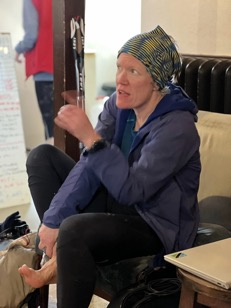
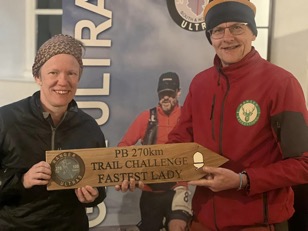
Happy, chatty and sleepy at the finish.
The race was extremely well organised and overall it was an enjoyable experience, despite the curveballs the weather and my body threw at me. The 3rd night was one of the most beautiful nights I’ve had on a multi-day race; sitting on a style eating a sandwich as the Sun rose in an almost cloudless sky is a memory that will live with me. I’m a bit disappointed by how slow I was, and embarrassed by having people come out to look for me and also by needing to ask for help to manage my period. At the time I was puzzled by why I was so slow on the last day when I was feeling so good. But in retrospect I suspect I had it the wrong way around; I was feeling so good because I was going so slowly. Ultimately what difference would finishing a few hours faster have made to anything? And I do have a long-race finish in the bag for 2024, unlike 2023 (I’m sitting at home writing this when I should have been in Sweden running a six-day race…).
The period bit at the end
Almost every multi-day race I’ve done in the past few years my period has started early during it or immediately afterwards (the one exception was ‘Six days in the dome’ where I took norethisterone and various weird things happened to my body). So I was unsurprised and prepared for my period starting ten days early on the 2nd night of the Pennine Bridleway. However, I wasn’t expecting or prepared for what happened the next night. Two hours after leaving Settle I stopped for a quick wee. Looking down I was shocked to see my thighs covered in blood and a huge red puddle inside my waterproof trousers. These days I usually get one heavy (and painful) day a month. However, it’s heavy as in ‘change super plus tampons every 4 hours’, not ‘completely soak through one and make a mess in 2 hours’.
I didn’t change the tampon. I had what should have been 24 hours worth with me, but at this flow rate, I was going to have to ration them. Plus my location (on the outskirts of a village) was fine for a wee stop, but not tampon changing. Because of my cold, I had lots of tissues on me, so I quickly cleaned up the worst of the mess, stuffed a handful in my pants and plodded on. I really hate asking for help, but I couldn’t work out how to handle this on my own. The waterproof trousers would keep the blood in, but at the cost of chafing and overheating once the Sun came up. So in the next village, I sat down on a bench, got my phone out and messaged the race organisers explaining the situation and asking if they could get some tampons to the next water point.
I got through the night with the tissues and ‘should have been 24 hours’ supplies. On reaching the water point at the top of Cam High road just after dawn, I was very happy to be told that they’d got my message and what I’d asked for was waiting on the passenger seat of one of the vehicles. The discreteness was thoughtful. But to be honest I’d have been happy (and relieved) to be greeted by someone waving a fistful of tampons and shouting ‘Anne: we’ve got you tampons’ through a loud hailer. And it wasn’t just tampons but a plastic container with towels and some wipes too. I stuffed my pockets and plodded off to find a secluded wall for a temporary sort-out until I got to the public toilets at Garsdale.